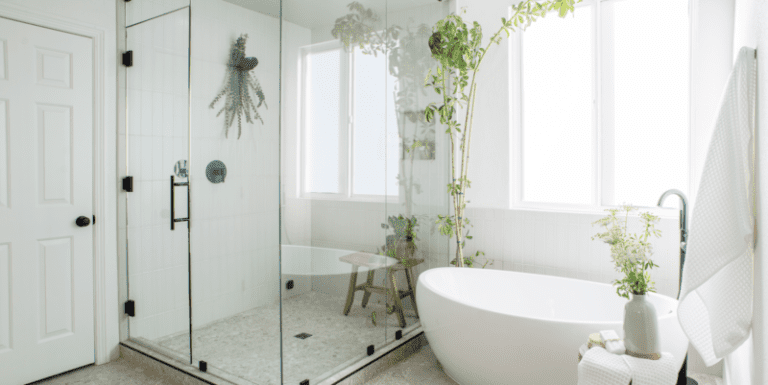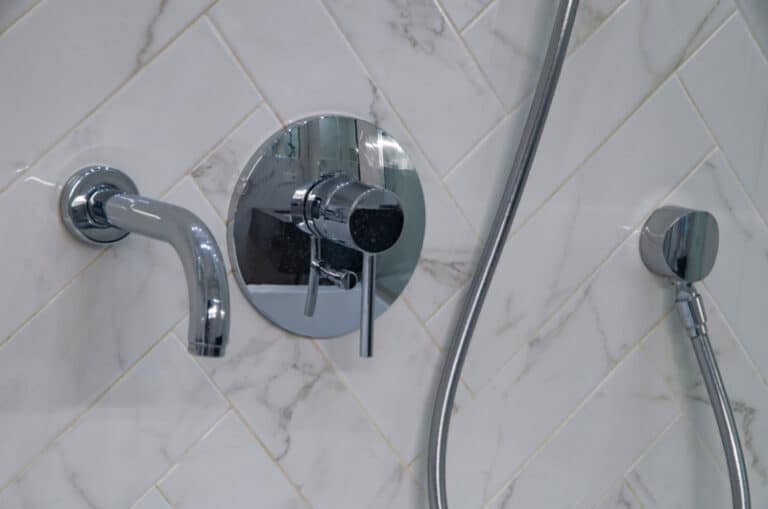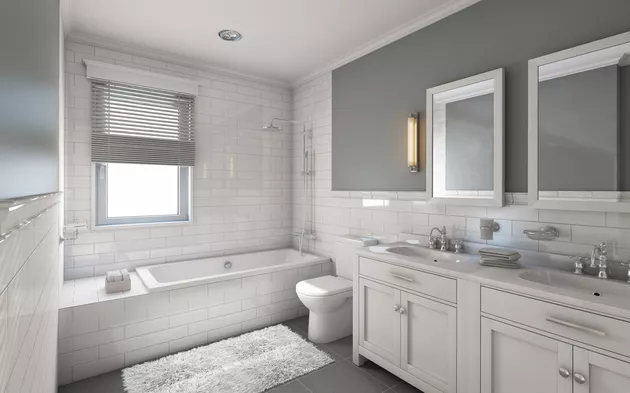How to Caulk a Shower Properly

Caulking your shower probably isn’t at the top of your list of enjoyable activities. However, it needs to be done, even if it ranks slightly better than cleaning the gutters.
The good news is, it’s not that difficult to caulk a shower. You just need to follow the proper steps to do it correctly.
Gather Your Supplies
Before you start working, you should gather everything you’ll need.
Choose a Caulk Removal Tool
First, you’ll need a tool to remove the old caulk. You can do this with a razor blade, utility knife, or a painter’s tool. If you are working on a plastic shower or tub, it’s best to use a plastic blade. This will avoid any cuts or scratches on the plastic surface.
You’ll also need to select your caulk. The two types of caulk that are recommended for showers are silicone and latex.
Silicone Caulk
Silicone is highly flexible. It’s waterproof and lasts longer than latex caulk. There are a few downsides, however. It is harder to work with, because it isn’t as easy to shape or smooth as latex.
It’s also a little harder to clean up. You’ll need mineral spirits to clean up silicone caulk. Latex caulk is water soluble when wet, so it can be cleaned up with soap and water.
Latex Caulk
Latex caulk is easier to use than silicone caulk, which makes ti popular. This is particularly true if you are new to caulking. When wet, it cleans up easily with soap and water. It’s easier to shape and smooth than silicone caulk, which can give you a more uniform appearance once its’ dry.
It comes in more colors than silicone based caulk as well. If you have a uniquely colored shower, you may want to choose latex caulk.
The downside of latex caulk is that it doesn’t have the lifespan of silicone. When it dries, it becomes harder and contracts more than silicone, which will shorten its lifespan.
Choose a Caulking Gun
Caulk guns are pretty inexpensive. Professionals debate over which caulking gun is the best. Let’s face it, we are not professionals. For caulking a shower, any decent caulk gun will work.
Cradle caulk guns are the best. If you choose a frame caulk gun, get one that says dripless. Don’t feel like you need to spend a ton on a caulking gun. It’s a good idea to choose a mid-range gun, which will cost about $20 to $30.
Other Supplies
There are a few other supplies you need. It’s a good idea to wear gloves when applying caulk, particularly silicone caulk. The caulk will inevitably get on your hands, and gloves are easier to remove than caulk.
The other supply you will need is rags. Those old rags that you keep around rather than throwing them away are perfect. If you are using silicone caulk, you’ll need to toss these after using.
If you are using latex caulk, soaking them in a bucket of water after using can remove the caulk, so the rags can be reused. Shop rags are also an option.
Just be sure that whatever you use is smooth and lint free. Standard paper towels aren’t a great option. You should also avoid terry cloth.
You may also want to have masking or painter’s tape. This isn’t a necessity, but it can make the process easier by providing a straight clean line.
Preparing the Shower
Before you caulk your shower, you’ll need to prepare it first. This includes removing the old caulk, cleaning the area, and allowing it to dry.
The Slice and Pull Method
If you don’t remove the old caulk, the new caulk won’t bond well. It will also look significantly less attractive. So, to caulk properly, you start by removing the old stuff.
If you are caulking a new shower or tub, you can skip this step. Go to the next section, “clean the area”, to get started.
Start by sliding the tool underneath the caulk to loosen it. You can then run it on either side of the caulk, to detach it completely.
Ideally, you’ll be able to pull the caulk away in long strips now. If it doesn’t pull lose, try loosening the caulk again. You can also use your tool to pull the caulk away.
Clean the Area
Now that you’ve removed the majority of the caulk, you will need to remove any residue or small pieces of caulk.
If the existing caulk is made of latex, you can use an abrasive pad and a multi-purpose cleaner. If the caulk is silicone, you can use a solution of mineral spirits or alcohol to remove any remaining residue.
If you see any mold or mildew in the area, you should eliminate it before continuing. Use one part bleach to two parts water. This will kill any mold.
Once this is completed, wipe the area with a damp cloth. This will help remove any remaining dirt or debris. Follow up with a dry cloth or paper towels.
Allow the area to dry completely before continuing to the next step.
Using Masking Tape
If you want to use masking tape, this is the time to apply it. Be sure to put it in a straight line, leaving a gap of 3/8 inch between the pieces of tape. This is the area you will fill with caulk.
How to Caulk a Shower
Now you are ready to caulk your shower. You’ll need to open the caulk, put into the caulk gun, and then caulk the area.
Opening the Caulk Tube
Start by opening the caulk tube. You’ll see a ring on the tip of the tube. Use a knife or scissors to cut the tip right before the ring. It’s best to cut it at a 45 degree angle, but don’t worry if it’s a straight cut.
If there’s a burr on the tip, remove it with your knife or sandpaper. This can interfere with your bead.
Now, you’ll need to break the inner seal. The easiest way to do this is with a nail. Just push it into the tip, until you feel it break the seal. You can also use a stiff wire if a nail won’t reach.
Putting the Caulk into the Gun
Pull the plunger of the gun all the way out. Then put the caulk tube into the gun chamber. Push the plunger down into the tube until you feel pressure.
Apply pressure until the caulk begins to come out. Wipe this away with a rag. Now, you are ready to caulk.
Applying the Caulk
Start at the top of the seam you want to caulk. Place the tip in the center of the gap. It should touch the surface of the joint, and be held at a 45 degree angle.
Apply even pressure, and move the gun down the seam as needed. You should be moving at the same speed the caulk is coming out. This allows you to create an even bead. You can push or pull the gun. Either method works well, so it’s simply a question of preference.
Finishing Touches
Once you have finished the seam, it’s time to smooth out the bead of caulk. You can do this with your finger, or a clean damp rag. If you didn’t use masking tape, you may need to wipe excess caulk away from the edges of the seam as well.
If you used masking tape, you should remove it now. Use a downward motion when removing the tape. This should leave a clean straight line on each side of the bead.
Once you are finished, clean up any areas that accidentally got caulking on them. If you have a spot on your shower stall, for example, be sure to remove it before it dries.
Allow the Caulk to Dry
Once you have finished caulking, it will need to dry. Most types of caulk need 24 hours to dry. However, quick dry varieties can be cured in as little as 30 minutes. Check the caulk package to see how long your caulk needs to dry.
How to Caulk a Shower Properly FAQs
What type of caulk is the best for showers?
Best is a relative term. If you mean the longest lasting, silicone is best if it won’t come into contact with paint. You can also choose a silicone/latex blend. This offers the best of both worlds.
Can you caulk over grout?
Caulking over grout isn’t a great idea. It will work temporarily. However, caulk doesn’t bond well with grout. This means eventually it will begin coming lose from the grout.
How do you know when to recaulk?
Caulking needs to be performed when the current caulk begins to fail. Cracking, missing, or peeling caulking is a sure sign you need to re-caulk. You should also look for signs of mold or mildew. This can occur beneath the caulk, because the caulk comes away from the gap, allowing water to penetrate it.
You can also read:






